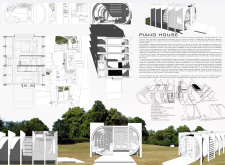5 key facts about this project
The Piano House functions as a residential dwelling designed with the intention of accommodating modern lifestyles. It emphasizes open spaces that promote social interactions among inhabitants while ensuring private zones remain sheltered from public view. The design encourages a seamless flow between interior and exterior elements, inviting natural light and integrating the home with its natural landscape. By utilizing transparent materials such as expansive glass panels, the architecture allows residents to enjoy unobstructed views, enhancing the connection to the outdoors.
Important components of the Piano House include its distinctive curved walls, which contribute to both visual interest and acoustic comfort. This architectural feature, reminiscent of the body of a piano, symbolizes the marriage of function and artistic expression. Within the living area, an open layout maximizes space efficiency, allowing the kitchen, dining, and lounge areas to blend effortlessly. This design encourages adaptability and flexibility, creating an environment that meets varying family needs.
The material selection is one of the project’s more significant aspects, as it incorporates a range of elements that support its functionality and aesthetic appeal. Reinforced concrete forms the robust skeleton, providing the necessary structural support while allowing for the complex shapes created by the design. The extensive use of glass not only promotes a feeling of openness but also enhances energy efficiency through the application of high-performance glazing. Steel framework complements the concrete, ensuring stability. The warmth introduced through wooden finishes adds depth and comfort to the interior spaces.
Unique to the Piano House is its emphasis on sustainability; this design integrates both passive and active environmental strategies. Natural ventilation is carefully considered through the layout, which promotes airflow, reducing reliance on mechanical systems. Furthermore, the incorporation of green roofs or vertical gardens aids in improving biodiversity and managing stormwater effectively, contributing positively to the building's ecological footprint. This commitment to sustainable design principles is reflected in the adaptability of the layout, allowing spaces to be easily reconfigured according to the evolving needs of the residents.
Overall, the Piano House stands as a comprehensive example of how architecture can address contemporary living requirements while remaining sensitive to environmental concerns. Its thoughtful integration of spatial organization, materiality, and design outcomes showcases the potential of residential structures to create enriching environments. For those interested in exploring this project further, the architectural plans, sections, designs, and ideas presented provide a deeper look into the innovative approaches that define the Piano House. Exploring these elements will offer valuable insights into how such architecture can effectively respond to the complexities of modern living.























